
by Max Wyss Wednesday, June 6, 2012
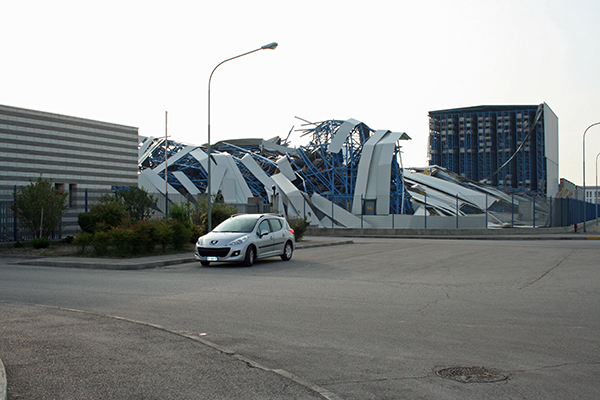
This industrial facility near Sant'Agostino, Italy, collapsed in the May 20 earthquake in Emilia-Romagna, killing two people. The plant was only built two years ago. Max Wyss
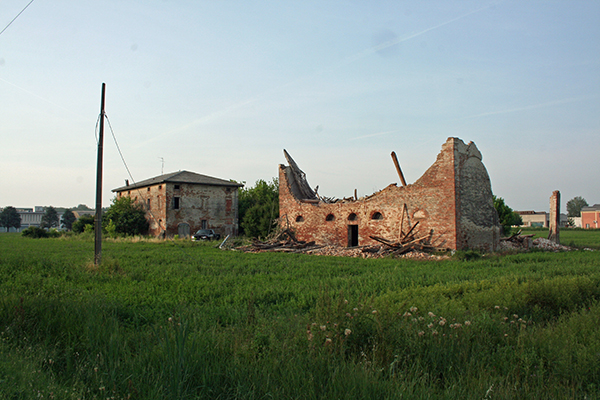
Although the old brick barn did collapse during the May 20 earthquake, this abandoned brick farmhouse — within view of the industrial facility near Sant'Agostino that collapsed — is still standing. Max Wyss
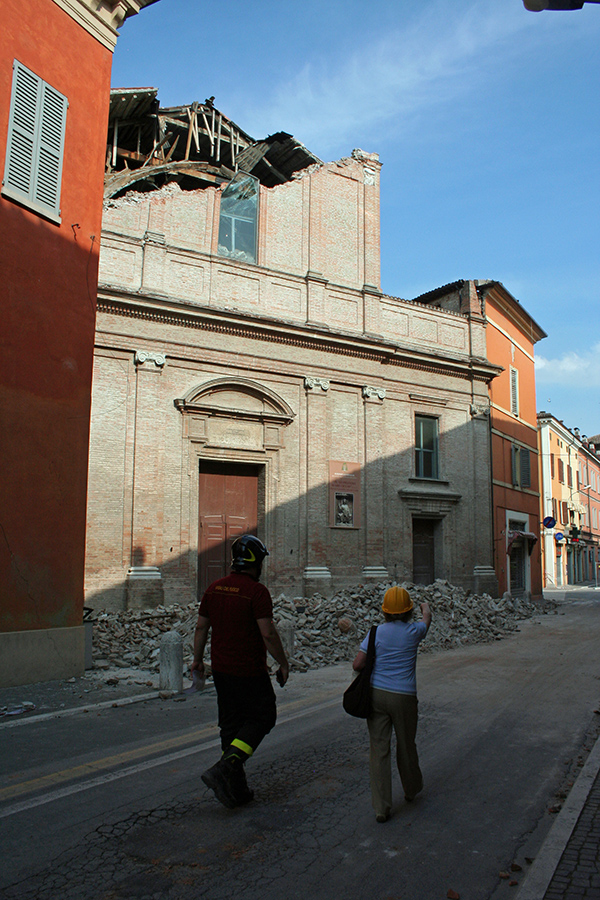
A firefighter escorts a resident through a cordoned-off section of Finale Emilia so she can retrieve some personal items from her apartment, which has been deemed uninhabitable. Max Wyss
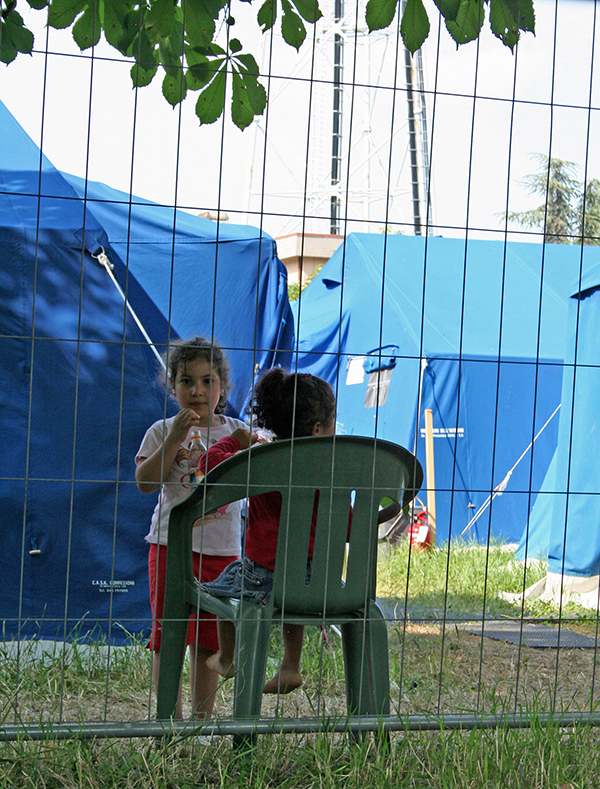
Thousands of residents of the Emilia-Romagna region are living in tents, unable to return to damaged homes while aftershocks continue. Max Wyss
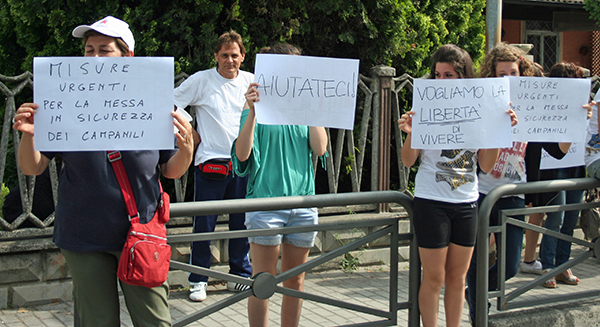
Protesters block the main road through a small town in northern Italy; they are upset with government officials who the protesters say are not doing enough to help repair the damaged belltower in the center of town. With the belltower cordoned off, the center of town is closed. Max Wyss
On May 29, eighteen people died in northern Italy when a magnitude-5.8 earthquake struck near the town of Mirandola. Arguably, these deaths were preventable, and they bring up the questions of how we can prevent such deaths in the future. Building codes are key in protecting people. If the most modern buildings collapse while old ones remain standing, something is wrong.
The May 29 quake was an aftershock of a May 20 magnitude-6.1 shock near Finale Emilia, a city in the Emilia-Romagna region. That quake struck at 4:03 a.m. local time, sending the terrified residents of Finale Emilia and surrounding areas out of their houses into the night. Although the damage to the built environment was extensive, with churches hit worst, only seven people died. Firefighters, civil protection officers and engineers moved fast to identify the parts of towns and individual residences that are unsafe and cordoned them off. The badly hit towns like Finale Emilia turned into ghost towns overnight and local schoolchildren found notes at the gates of their schools telling them to start summer vacation immediately. Meanwhile, an estimated 13,000 people are living in tents, most having lost their jobs for the time being, until the aftershocks end and the buildings are replaced or repaired.
In the weeks following the main shock, thousands of aftershocks have struck the region, including the one in Mirandola.
First, let’s get a handle on the geology. The ongoing aftershocks are ordinary: Most strong earthquakes are followed by aftershocks of smaller magnitude that diminish over time. (Additionally, some main shocks are preceded by foreshocks. There are no methods to identify an earthquake as a foreshock, thus any strong event could be followed by an even stronger main shock.) Foreshocks, main shocks and aftershocks are dependent on each other because of the stress redistribution due to each rupture. When the ruptures follow each other within seconds, the event is considered a single event but a complex multiple rupture, a common occurrence in very large earthquakes. When an earthquake sequence does not contain an outstandingly largest event, seismologists speak of an earthquake swarm. In this case, an earthquake swarm with several strong shocks is causing damage and spreading fear.
The main shock and aftershocks have outlined the fault rupture plane as striking east-west with slip to the north, pushing Italy northward as part of the African Plate slides beneath the European Plate. It is a common occurrence that ruptures are extended along the same fault plane in order to relieve the stress concentrations accumulated at the end of the initial rupture. For example, aftershocks and extension of the rupture plane to the south-east have continued to occur up to the present since the great magnitude-9.3 Sumatra earthquake in December 2004.
Thus, the possibility exists that the current earthquake activity in northern Italy may continue to extend to the west and the east along the fault lines, and may include events of magnitude 6.0 and even larger. This has happened before, like in the Friuli region of northern Italy, where an earthquake swarm in 1976-1977 included three shocks with magnitude near 6.0 and killed about 2,000 people. So it is important that people in communities along the fault lines to the east and west of Finale Emilia and Mirandola be aware that a quake may occur.
Being prepared by bolting down furniture and by installing an earthquake protection unit — a reinforced room that is at least somewhat impervious to severe shaking, a concept that I detail in an April paper in the journal Natural Hazards (pdf) — is important and it’s all people can do, short of evacuation. Of course, scientists and government officials would be hard-pressed to suggest full evacuation of any communities along a fault line that may or may not rupture.
Interestingly, a similar scenario has arisen in the wake of the magnitude-6.3 quake in L’Aquila, Italy, that killed 308 people in April 2009. In that case, the region had been struck by hundreds of minor registered earthquakes over a period of two and a half months. Worried citizens and officials gathered experts to ask them whether or not the city should be evacuated — basically, whether a larger quake was imminent. The factual advice was that many similar earthquake swarms have occurred in Italy without being followed by a strongly damaging main shock. So people stayed put and there was a tragic quake a few days later. The government has now charged the seismologists with manslaughter for not warning the population adequately and that case is currently in the courts in Italy.
Here’s the question though: Would the same experts find themselves in court, had they recommended evacuation and no disastrous earthquake had followed in L’Aquila? Likewise, should the experts now evacuate communities that may experience an earthquake in this current sequence in Emilia-Romagna? Or, given that we have no way of actually predicting earthquakes, is that taking a step too far?
After the L’Aquila earthquake, Thomas van Stiphout and Stefan Wiemer of the Swiss Seismological Service at ETH Zurich and Warner Marzocchi of the Istituto Nazionale di Geofisica e Vulcanologia in Italy undertook a study of the cost-benefit ratio of evacuating or not evacuating, given the probability of a following strong earthquake, the seismic activity in the foreshock sequence and the probabilities that larger earthquakes may follow. The probability that a magnitude-6.0 class earthquake would follow the swarm felt in L’Aquila did not climb high enough as a function of time that it was prudent to evacuate, unless the value of a human life is set very large, they reported in Geophysical Research Letters in 2010. It is clear that the decision to spend significant sums of money and incur significant economic losses to evacuate becomes very difficult when the uncertain loss of human lives is placed on one side of the balance in the cost-benefit ratio. In such a case it is exceptionally hard to know what to do.
It is unknown how close to failure-stress the eastern and western ends of the May 2012 ruptures in Emilia-Romagna are and whether or not the sequence will continue with strong shocks. Consequently, it seems mandatory that the population in the area of ongoing aftershocks, stay out of damaged buildings until they are repaired.
I just returned from the region, where I witnessed that the Italian government officials, firefighters, civil protection personnel, engineers and seismologists are doing an outstanding job of cordoning off the parts of Finale Emilia, Sant’Agostino, Mirandola, other smaller towns and individual residences in the countryside that have been damaged and are unsafe to enter. The firefighters are extremely helpful in guiding distraught people to their dwellings and gathering a few most necessary possessions for them, while the people wait in the street because it is unsafe for them to enter their homes. Thanks to the vigil of the firefighters, the already-damaged regions are unlikely to see more deaths.
But what about communities to the east and west of the area of ongoing aftershocks? What should they do? After seeing the case of Mirandola, where the majority of the casualties occurred in industrial facilities, such as factories, manufacturing plants and storage warehouses, it seems necessary that the building styles and quality of construction of industrial facilities in the region be reviewed. Paradoxically, many lives were saved because the first earthquake on May 20 occurred at 4:03 a.m., when people were home sleeping and not at work in the collapsing industrial facilities.
This was not the case in the second shock: People were at work. Looking at the endless rows of modern buildings without walls or without roofs in the industrial zones of Mirandola, Medolla and Sant’Agostino, one is forced to wonder what building codes exist for industrial buildings that collapsed, when they are within a stone’s throw of old, arguably poorly built brick farms that did not collapse.
There seems to exist no easy solution to the dilemma society faces in case of earthquake swarms, which may or may not be foreshocks.
Whereas all matters concerning the probability estimates of future damaging earthquakes involve great uncertainties, one fact is certain: Not enough research focuses on estimating seismic hazard and risk, identifying foreshocks as such, estimating probabilities of future damaging earthquakes, and solving the sociological problem of preparing for disastrous earthquakes.
In the meantime, citizens need to just prepare as best they can.
© 2008-2021. All rights reserved. Any copying, redistribution or retransmission of any of the contents of this service without the expressed written permission of the American Geosciences Institute is expressly prohibited. Click here for all copyright requests.